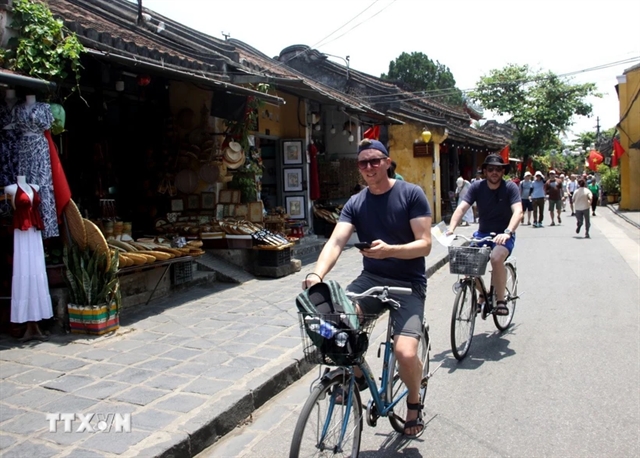 Life & Style
Life & Style


|
| International tourists cycle through the ancient streets of Hội An. — VNA/VNS Photo Trịnh Bang Nhiệm |
HỘI AN — The ancient city of Hội An in the central province of Quảng Nam, Việt Nam, boasts a rich cultural mix and stunning natural beauty, making it an attractive destination for cyclists eager to experience the country's diverse landscapes.
In celebration of World Bicycle Day on Tuesday, the digital travel platform Agoda has named Hội An one of the top five cycling destinations in Asia.
The other ideal cycling locations are Hokkaido (Japan), Luang Prabang (Laos), Sun Moon Lake (Taiwan, China) and Sukhothai (Thailand).
Agoda highlights that cyclists can explore both the ancient city and its picturesque countryside, enjoying beautiful routes through rice fields, coastal roads and vibrant local villages. Accommodation options range from hotels to luxury resorts, catering to various preferences.
Nestled along the banks of the poetic Hoài River, 30km from Đà Nẵng, Hội An has long been a favoured destination for both domestic and international tourists. Over the years, the town has weathered many historical changes, emerging with a tranquil and timeless beauty that contrasts sharply with modern urban life.
Visitors are captivated by Hội An's moss-roofed houses, ancient yellow-painted walls and iconic lanterns, all integral to its unique charm. Since its development in the 16th century, Hội An was once one of the busiest international trading ports in the region, attracting merchants from China, Japan, the Netherlands, India, Spain and beyond.
This rich history has left a profound architectural and cultural legacy, blending Eastern and Western influences.
Hội An is renowned for its traditional trading port architecture, much of which remains well-preserved today.
The town's architectural works, religious sites, and cultural values vividly reflect its historical evolution. It boasts a remarkable collection of 1,360 relics, including 1,068 ancient houses, 11 ancient wells, 38 clan churches, 19 pagodas, 43 shrines, 23 communal houses, 44 unique ancient tombs and an ancient bridge.
As visitors stroll through this enchanting town, they can immerse themselves in its artistic heritage, featuring a blend of architectural styles from various cultures. The town is home to centuries-old pagodas such as Cầu Pagoda, Phước Lâm Pagoda and Vạn Đức Pagoda, alongside Chinese assembly halls and temples adorned with intricate and colourful designs.
In addition to its architectural significance, Hội An is a living museum of intangible cultural heritage.
Despite the passage of time, the daily lives of the people in Hội An maintain their original charm, away from the hustle and bustle of modern life. The streets are laid out in a chessboard pattern, winding along the river and embracing the traditional houses.
In the peaceful corners of Hội An, visitors can discover street vendors offering local delicacies such as cao lầu soup, Quảng noodles, breads and chicken rice, as well as shops selling handicrafts. These experiences reflect the simple, slow and sincere way of life that characterises Hội An.
Recognised by UNESCO as a World Cultural Heritage site in 1999, Hội An has received numerous accolades from prestigious organisations and publications as a leading urban cultural destination in Asia and one of the top 15 most wonderful cities in the world. VNS




